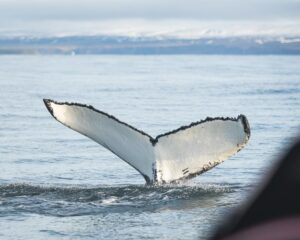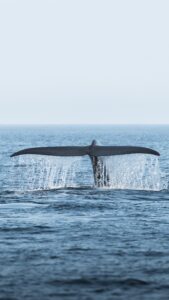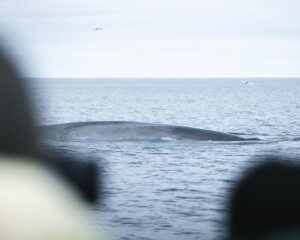The Humpback surfaces close to us, its broad back arching once again, then rolling downwards, showing its characteristic namesake hump-like dorsal fin until its tail fluke slowly lifts clear of the water. Water cascades off the tip as it sinks below the surface, leaving only the ripples of its fluke print.
Too big for a humpback whale?

Moments later, we get a call over the radio from one of our colleagues on a North Sailing vessel. Using binoculars, they spotted a blow some three and a half miles distant. It’s big, almost certainly too big for a Humpback. We look at each other, none of the crew want to say it… Could it be? Robert, the Captain, delicately eases us away from the newly surfaced Humpback. Once we are a safe distance away, Robert increases the throttle, and soon we are skipping across the chop at speed, heading towards where the whale’s blow was last seen. This is one of the big advantages of a RIB (Rigid Inflatable Boat): we are fast and maneuverable and can close the three miles in a few minutes. Also, being low in the water, we are right where the action is!
The largest animal on our planet

The tension mounts as we search the horizon of Iceland’s Skjálfandi Bay for our new whale… Everyone’s eyes are peeled, although we haven’t told the guests about our suspicion it’s clear from our faces that something is about to happen. No one speaks, everyone on board is staring seaward as I make my way to the bow. Although I have guided in other places for quite a while this is my first season in Húsavík. I am aware of everyone’s excitement as I continue to scan the horizon as the RIB comes to a stop. Nothing, not even the wind moves the surface of the ocean. A sense of disappointment starts to come over me, perhaps whatever it was has gone? This is always the risk of working with wild animals in their natural habitat. Then it happens……. The colossal mass of what can only be a Blue whale breaks the surface about 60 meters away. As it exhales hard a plume of CO2 and water vapor is thrown ten meters high in the air and hangs in a fine mist. As the whale inhales the sound of air rushing into its blowholes fills our ears. It’s almost inconceivable just how much air it sucks in, up to 5000 liters of clean fresh Icelandic air. That’s around 90% of their lung capacity. On average humans only exchange around 25-30%. After it exhales it starts it’s slow roll beneath the surface. The head dips and the back arches and submerges, rolling downwards for what seems like minutes until we finally see its characteristic tiny dorsal fin set well back towards the tail. Just like that the Blue whale is gone again, disappearing below the waves as if in an il
lusionist’s trick. Just a few ripples and some chattering Arctic Terns remain. Weighing up to 190 tonnes (equivalent to five double decker London buses) and reaching almost 30 meters it appears unreal how silently it has vanished.
Passion for whales in Húsavík

Passion for Whale Watching is Húsavík Adventures core value and sharing this sighting of a rare Blue Whale with excited guests is a humbling experience.
After the initial excitement onboard I turn to see our guests sitting in wonderstruck silence, they should be, less than 1% of the planet has been lucky enough to see a Blue whale. The gentleman closest to me smiles and lifts his
open palm offering me a high five. The look on his face says it all, absolute awe. He beams as our hands clasp. His joy and emotion washes over me as our eyes meet and I find it hard to speak for a moment. This is why we love this job, this is why we are so passionate about Skjálfandi Bay and Húsavík. The reality of what we just witnessed sets in slowly as I start to explain to our guests about this amazing creature, the largest animal to have ever lived on Planet Earth.
Creating lifetime memories

The whale surfaces multiple times that afternoon as it feeds on its diet of plankton and Krill. Photos are taken, questions asked and a lifetime memory is made. Finally, with love and happiness in our hearts, we turn the bow towards home.
Written by our new guide Austin Wainwright. Welcome to the team!

